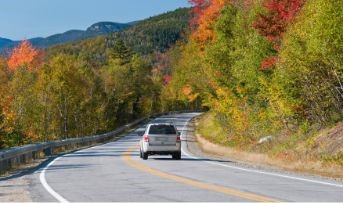Blog Details - Magma HDI

Best tips to perfectly drive a car upward on a slope 4th May 2019
Most drivers would agree that driving is a non-challenging task for the most part. Driving on straight, flat roads is a breeze if you practise lane driving and indicate clearly. New drivers face issues only when they face inclined roads. Greatly dependent on the driver’s skill, confidence, judgement, and the slope gradient, with the following tips, you can zip through meandering bends on slopes with ease!
While perfect control over the ABCs- Accelerator, Brake, and Clutch can help prevent accidents, car insurance helps minimise the financial damages that result from accidents. Therefore, before you take on the task, purchase a comprehensive car insurance policy that covers the risk of any mishaps you may encounter on your driving adventures.
1. Do not panic
The first step towards driving failure is panicking. Approach the situation level-headedly when you spot an incoming inclination. It is natural for the car to roll back while you steer it upwards. However, with your right leg ready to switch from the accelerator to step on the break and your left hand ready to engage the hand brake, clear assessment can help you avoid collisions on your ascent.
2. Avoid paddling
Paddling is a technique that relies entirely on car pedals. It requires great concentration and skill to gauge when to switch between the brake and the accelerator. It eliminates the need for handbraking. Drivers start the climb by engaging the clutch and brake before putting the car in first gear. When the gear is engaged, you must shift from the brake to the accelerator while slowly releasing the clutch.
You need to ensure that the pressure applied on the accelerator is not too hard, as it ruins the pedal functioning in the long run. It also adversely affects the car’s engine and excessively consumes fuel. Considering that car insurance does not compensate for accidents caused by engine damage due to long-term use, it is best to avoid the technique.
3. Familiarise yourself with the handbrake
Straight, flat roads do not require drivers to use the handbrake regularly except while parking. However, using the handbrake while starting your vehicle on inclinations is ideal. Ensure that you are used to engaging and disengaging the brake lever. While most automobiles have a standard handbrake, some may have an awkwardly placed or difficult-to-engage lever that you must familiarise yourself with before tackling slopes.
4. Use diesel-induced torque efficiently
Diesel cars have an advantage over petrol or CNG vehicles in terms of engine torque. Torque is the ability of the car to perform, which is directly impacted by its fuel. A diesel-fueled car on inclined roads is ideal for faster acceleration and a firm grip, minimising the chances of rolling back.
5. Maintain distance from the car ahead
While maintaining a safe distance is necessary on all roads, slopes are critical to prevent collisions if the car ahead rolls back. This prevents you from panicking and making poor decisions due to a lack of time to act.
6. Stick to lower gears
The lower the gear, the lesser the resistance and the easier the climb. While starting the climb, stick to the first gear and move up to the second or third gear at most if the inclination gradually reduces. If you feel your car rumble, reduce your acceleration, engage the clutch, and drop the gear to prevent your engine from shutting down.
7. Use the handbraking technique
The paddling technique used moderately while relying on the handbrake is the best approach for uphill drives. While ascending, the car is put in first gear and accelerated slowly immediately upon release of the handbrake. This makes the car move forward. To take the vehicle further, apply pressure on the accelerator and slowly release the clutch.
Driving upwards on a slope may initially seem daunting, but even beginners can ace the task with adequate practice. As a precautionary mechanism, one must always purchase car insurance with a sufficient sum and coverage to minimise the cost of accidents and allied damages.
Click HERE to buy the best car insurance policy.
Disclaimer: The information provided above is for illustrative purposes only. To get more details, please refer to policy wordings and prospectus before purchasing a policy.

